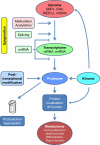Radiogenomics: A systems biology approach to understanding genetic risk factors for radiotherapy toxicity?
- PMID: 26944314
- PMCID: PMC5016239
- DOI: 10.1016/j.canlet.2016.02.035
Radiogenomics: A systems biology approach to understanding genetic risk factors for radiotherapy toxicity?
Abstract
Adverse reactions in normal tissue after radiotherapy (RT) limit the dose that can be given to tumour cells. Since 80% of individual variation in clinical response is estimated to be caused by patient-related factors, identifying these factors might allow prediction of patients with increased risk of developing severe reactions. While inactivation of cell renewal is considered a major cause of toxicity in early-reacting normal tissues, complex interactions involving multiple cell types, cytokines, and hypoxia seem important for late reactions. Here, we review 'omics' approaches such as screening of genetic polymorphisms or gene expression analysis, and assess the potential of epigenetic factors, posttranslational modification, signal transduction, and metabolism. Furthermore, functional assays have suggested possible associations with clinical risk of adverse reaction. Pathway analysis incorporating different 'omics' approaches may be more efficient in identifying critical pathways than pathway analysis based on single 'omics' data sets. Integrating these pathways with functional assays may be powerful in identifying multiple subgroups of RT patients characterised by different mechanisms. Thus 'omics' and functional approaches may synergise if they are integrated into radiogenomics 'systems biology' to facilitate the goal of individualised radiotherapy.
Keywords: Gene expression microarrays; Genome-wide association studies; Normal-tissue reaction; Predictive tests; Radiotherapy; Single-nucleotide polymorphisms.
Copyright © 2016 Elsevier Ireland Ltd. All rights reserved.
Figures



References
-
- Jemal A, Bray F, Center MM, Ferlay J, Ward E, Forman D. Global cancer statistics. CA: a cancer journal for clinicians. 2011;61(2):69–90. - PubMed
-
- Safwat A, Bentzen SM, Turesson I, Hendry JH. Deterministic rather than stochastic factors explain most of the variation in the expression of skin telangiectasia after radiotherapy. Int J Radiat Oncol Biol Phys. 2002;52(1):198–204. - PubMed
-
- Tucker SL, Turesson I, Thames HD. Evidence for individual differences in the radiosensitivity of human skin. Eur J Cancer. 1992;28A(11):1783–91. - PubMed
-
- Turesson I. Individual variation and dose dependency in the progression rate of skin telangiectasia. Int J Radiat Oncol Biol Phys. 1990;19(6):1569–74. - PubMed
-
- Potten CS. Cell cycles in cell hierarchies. International journal of radiation biology and related studies in physics, chemistry, and medicine. 1986;49(2):257–78. - PubMed
Publication types
MeSH terms
Substances
Grants and funding
LinkOut - more resources
Full Text Sources
Other Literature Sources
Medical

